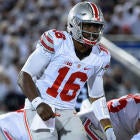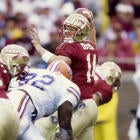Offensive woes at Ohio State and Auburn call for two different solutions. Meanwhile, there's nothing but good news coming out of Oklahoma and Oregon. With Week 2 in the books and Week 3 coming up, I break it all down in the newest edition of Cover 3.
1. It's time for quarterback change at Ohio State
Following Ohio State's 31-16 loss at home to Oklahoma, Urban Meyer was asked if he would consider making a change at quarterback, sitting J.T. Barrett after consecutive lackluster passing outings to start the 2017 season. "No," Meyer said decidedly. No further explanation was offered.
This came after Barrett completed 19-of-35 passes for 183 yards and an interception in the Oklahoma loss. He was 5 of 11 for 26 yards in the first half.
Resolute as Meyer may be, a quarterback shuffle would serve Ohio State well.
I picked Ohio State to win a national championship this fall, and this is a team that will be disappointed with anything less. That's precisely why a move is essential. With Barrett under center, Ohio State is a conference title contender but a national title is out of reach. Great teams have consistently had his number for over a year.
Early last season, I spoke with opposing defensive coaches who were already sniffing out Ohio State's weakness: downfield passing and perimeter receiving threats. Teams were determined to make Barrett beat them with his arm from the pocket. But even with his limitations, and due in part to the athletes around him, most still could not.
But Penn State could. Michigan State could. Michigan could. Clemson certainly could, and so Ohio State's season ended without a national title opportunity..
This year was supposed to be different. New offensive coordinator Kevin Wilson and quarterback coach Ryan Day, who offered an NFL background, were supposed to help Barrett take the requisite steps forwards towards championship-level quarterback play.
But we saw his weaknesses again on Saturday night. There was a lack of rhythm in the passing game, his timing was off and vertical threats were non-existent. It was the same thing we saw at Indiana in Week 1 when Barrett padded a 304-yard passing line with underneath catch-and-run opportunities that turned into big plays. In short, this offense doesn't look much different than the group last year that had everyone wondering what's missing and had Barrett ranked outside the top 50 in passer rating beyond 20 yards per Pro Football Focus.
If this sounds reactionary, understand that I had a hunch this would happen. After Ohio State's spring game saw both of Barrett's backups put on a more proficient downfield passing show than the starter in front of them, I wrote that we could see drama in the fall. At that time, I thought that we could see calls for the better arm in Wilson's offense by midseason. Here we are ahead of schedule.
Were this any other program, you take your chances with the four-year starter, three-year captain and former Heisman Trophy front-runner. You live with the limitations. But this is Ohio State where Dwayne Haskins is on the bench with one of the best arms college football has never seen. He was ranked as the No. 5 pro-style quarterback in the Class of 2016 and had more than 35 offers from across the nation. In that spring scrimmage, Haskins was 9 of 13 for 153 yards with two touchdowns, while Barrett was 8 of 12 with 71 yards, a touchdown and a pick.
I feel confident that Haskins has one of the better arms you'll find in college football, but I'm not at practice. I'm not around the team every day. I don't know why Meyer and his staff may still be hesitant to hand him the keys. But that doesn't have to be the answer either.
Meyer won a national championship at Florida utilizing a two-quarterback system. Tim Tebow -- a freshman at the time -- was the physical run threat with pass-game limitations. Chris Leak was the accurate pocket passer who distributed the ball to a talented array of skill talent.
If Barrett is the leader Ohio State presents him to be, he'd be a great candidate to share reps with a more talented thrower to help expand and grow the Buckeye offense. A red zone and short yardage role at quarterback for Barrett could be the perfect way to lean on his intangibles in big moments while letting Haskins jump start the rest of the offense.
2. What's missing at Auburn?
There was a lot of blame to go around for Auburn offensively on Saturday in its 14-6 loss to Clemson. The 117 yards of offense, 11 sacks allowed and 15 second-half yards all paint a pretty clear picture of Auburn's ineptitude.
The biggest culprit for Auburn's struggles was Clemson's defense, and while Gus Malzahn may not face Clemson defensive coordinator Brent Venables again this season, he will certainly face the blueprint that Venables laid out before the nation Saturday night. So Malzahn needs to get things fixed and that fix starts in the run game.
In Jarrett Stidham, Gus Malzahn was supposed to have found his quarterback. A former five-star prospect who flashed tremendous ability as a true freshman at Baylor -- and checked out during spring, summer and fall practices -- Stidham looked capable of providing the passing competency that Auburn had lacked under Sean White and Jeremy Johnson. But I'm not sure that's what Auburn has been missing.
Over his last eight years overseeing offenses, Malzahn's had a running threat under center during four of those seasons (defined as a quarterback that rushed for more than 400 yards). In the seasons with a running quarterback, Malzahn's teams averaged more than 37 points per game. In the seasons with no run threat at quarterback, his teams averaged 29 points per game. Those teams averaged 78 less total yards of offense per game, too.
That quarterback run game was missing on Saturday night. In fact, a perimeter run threat was missing altogether. Auburn called 26 run plays on Saturday; 22 of them were north-south runs by 235-pound converted fullback Kamryn Pettway, and 20 of those were between-the-tackles runs. Among the other four called run plays, two were jet sweeps to Eli Stove, one was a toss to fullback Chandler Cox and one was a run-pass-option keep by Stidham. There was nothing about Auburn's offense that was threatening second level defenders laterally.
Clemson has arguably the two best defensive tackles in college football. Its middle linebacker is a 250-pound former five-star prospect. That group wasn't going to scare easily to a hobbled Pettway.
In those previously successful Malzahn offenses, there was always an east-west threat to keep defenses honest in the run game. An Onterrio McCaleb to complement Cam Newton's power, a Nick Marshall to counterpunch Tre Mason.
Kerryon Johnson can be that guy for Auburn this year, but in his absence, where was Kam Martin? Where was Stidham?
I don't contend that Stidham is Newton or Marshall, but he can be a run threat. He can keep defenses honest. He rushed for 750 yards as a senior in high school. He started at wide receiver as a sophomore. He's good enough to get linebackers second-guessing their eyes. He's good enough to attack the edge. He's good enough to give more than a token effort at an RPO bundle.
When Auburn finds rhythm in the run-game, the pass-game will follow.
3. Buy Oregon and Oklahoma stock
Following its win on Saturday, Oklahoma is ranked No. 2 in the country, and I'm putting a "buy" recommendation on Sooner stock if you can get it. That's because despite the lofty ranking, Oklahoma looks built to meet long-term expectations. Oklahoma's 34-year-old coach has already proven he can win a big game on the road. When it loses Heisman hopeful Baker Mayfield to graduation, Kyler Murray will step in as an equally dynamic playmaker at quarterback with a couple of seasons of eligibility to go.
And then there's the freshmen. The 2017 recruiting class for Oklahoma was a return to the elite after a substandard stretch. Bob Stoops' last class in Norman was ranked No. 8 nationally, the first top 10 recruiting finish since 2010. That group already looks poised to cash in on those expectations.
Kenneth Murray started at middle linebacker Saturday night and looked right at home for a suffocating defense with five tackles. Robert Barnes had an impact at safety. Grant Calcaterra at tight end, CeeDee Lamb at receiver and Trey Sermon at running back all made big plays in critical moments. It's one thing to make plays against UTEP, but these guys showed up in The Horseshoe and helped win a football game.
The class of 2018 under Lincoln Riley is trending the same way. Currently ranked No. 8 nationally, Riley could give OU its first back-to-back Top 10 class since that 2009-2010 stretch.
Oregon is on a similar path. Willie Taggart won his first test over the weekend against Nebraska showing the same kind of tempo-based spread attack that we're used to seeing in Oregon, but like Oklahoma, it was the freshmen that make the future look bright.
As a starter, cornerback Thomas Graham picked off NFL hopeful Tanner Lee twice. He dropped a third interception but caused another interception on Nebraska's first offensive play. Graham also had seven tackles and a tackle for loss. Two of Oregon's best interior defenders are already true freshmen Jordon Scott and Austin Faoliu, and Johnny Johnson made the catch of the day on offense. Add those guys to sophomores like linebacker Troy Dye, quarterback Justin Herbert and wide receiver Dillon Mitchell, and suddenly Oregon has a really talented core of athletes ready to be a foundation piece for the Taggart regime.
Taggart is doing his part, too. After closing strong in the class of 2017, Taggart is trending towards Oregon's highest ranked recruiting class of all time, currently sitting at No. 5 nationally. You have to know how to recruit to win on the biggest stage for the long haul, but recruiting alone won't cut it. Taggart and Riley seem to have a pretty good idea how to coach, too.





















